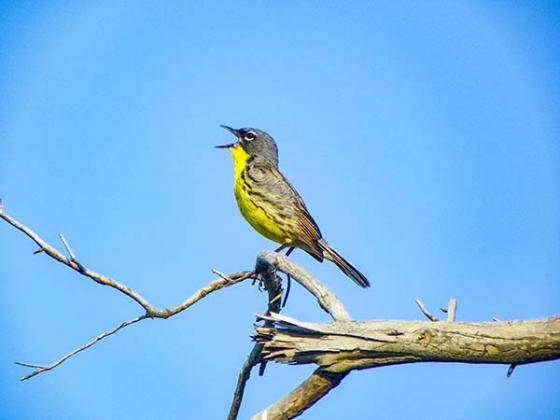By Karen Cleveland
Michigan Dept. of Natural Resources
LANSING — Driving down M-33, through the city of Mio in northern Michigan, a canny observer will note something unusual. In addition to the usual recognitions for residents who died during military service, there’s an edifice of stone and mortar that contains the effigy of a brilliant yellow and slaty gray songbird.
This isn’t a memorial but a monument to the ingenuity, tenacity, and dedication of scientists, conservationists and ordinary citizens determined to save one of Michigan’s most unique species – the Kirtland’s warbler.
We may never know the full story of Michigan’s Kirtland’s warblers. The scientific record reports precise, discrete facts: “first discovered in the United States in 1851,” “wintering grounds discovered in 1879,” and “nesting range discovered in 1903.”
But this simple narrative ignores the experiences of residents who knew these birds and passed their stories through oral traditions that may now be lost to history. It misses the messy and convoluted path of a species.
The Kirtland’s warbler is a small songbird that could comfortably fit in a cupped hand. Both males and females have lemony yellow breasts and bellies, slate gray heads and backs with black speckles across their bodies. They nest on the ground in thick, patchy jack pine thickets and overwinter in the Caribbean.
Nesting only in the jack pine forests, the great Midwest logging boom of the 1800s radically changed the landscape the warbler depended on. Removing the expansive forests of northern Michigan allowed the brown-headed cowbird, a grassland species, to move in.
Cowbirds are nest parasites. They don’t build their own nests, instead laying their eggs in the nests of other birds for them to raise. Research found when Kirtland’s warblers had to raise these interlopers as well as their own young, the young warblers didn’t get enough parental care to survive.
The logging boom also brought white settlers who strived to quash any fires that started in the forests that regrew. This kept fire from clearing old jack pines to let the young, dense stands the warblers needed grow. Fire also opened the jack pinecones, allowing seeds to drop for new growth.
It was a miracle there were any birds left in 1951, when an effort was launched to conduct a full census of the species.
As it’s still done today, counters visited the bird’s nesting habitat and counted the number of males that were singing to advertise and defend their territories. Studies suggested one female for each male.
Warbler counters in 1951 arrived at a final count of 1,000 birds. This remarkably small number, coupled with research that showed nests were producing relatively few young each year, galvanized the Michigan Department of Conservation (later Michigan Department of Natural Resources) to respond.
By 1958, core conservation areas had been identified on state-managed lands, where the department prioritized management for Kirtland’s warbler.
By 1963, the U.S. Forest Service had identified core areas on its own lands for conservation. By the end of the decade, the species would be listed as endangered by the U.S. Fish and Wildlife Service.
Keith Kintigh, the DNR’s Forest Conservation and Certification Specialist, is familiar with the challenges of conservation in northern Michigan with its patchwork of state forest, national forest and private lands.
“The coordination between the DNR, federal conservation agencies, researchers and citizen scientists to protect this species, really from the very beginning, was vital to any success we were going to see,” Kintigh said. “These partnerships formed the foundation of Kirtland’s warbler recovery efforts.”
Despite this, the 1971 warbler count found only about 400 birds. More action was needed.
Young forests were created by harvesting trees too old for the warblers to use and replanting with young trees. Wildlife biologists and foresters ensured timber harvests were staggered and ensuring the availability of the young forests the birds needed.
Steps were taken to restrict human disturbance around nesting areas. Efforts began to reduce the number of brown-headed cowbirds in the warbler’s nesting range. More northern, forested public land began to be managed to create Kirtland’s warbler habitat.
Yet warbler numbers continued to decline into the late 1980s, before things started to look up in the early 1990s. For the first time, nesting warblers were found outside their usual range, with birds being found in the Upper Peninsula.
The goal of the Kirtland’s warbler recovery team of 1,000 warbler pairs was met in 2001. In 2007, nesting warblers were also being found in Wisconsin and Ontario.
The secret to the Kirtland’s warbler’s success was tied to ongoing, long-term habitat management programs to replicate the effects of large-scale fires while not risking lives or livelihoods the way that wildfires can.
“We knew this species would continue to need our help, even after its numbers rebounded,” said Dan Kennedy, the DNR Wildlife Division’s endangered species coordinator. “So, we worked with our partners to develop a conservation plan in 2015 that laid out a path forward where we continued to work together to ensure the warbler wouldn’t become endangered again.”
Today, the Kirtland’s warbler is off the endangered species list, and its population has grown to over 4,500 birds, situated across Michigan, Wisconsin and Ontario.
The Kirtland’s Warbler Conservation Team coordinates the conservation work of the various agencies and organizations that continue to perform this work. The newly formed Kirtland’s Warbler Alliance seeks funding and volunteers to ensure resources are available.
Bill Rapai, interim executive director of the Kirtland’s Warbler Alliance, has been a long-time advocate for this small bird.
“What we want to share with Michiganders is that continuing to work to protect Kirtland’s warbler habitat into the future does more than just protect the warblers. The forests this bird counts on provide great hunting and fishing, birdwatching, photography, kayaking, foraging, camping and hiking opportunities,” Rapai said. “The cycle of harvest and replanting of jack pine helps to provide a boost to local economies. It’s a win for the warblers, but it’s a win for so much else as well.”


